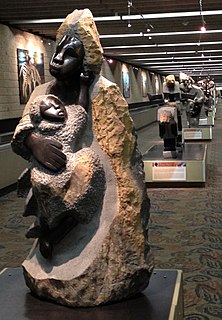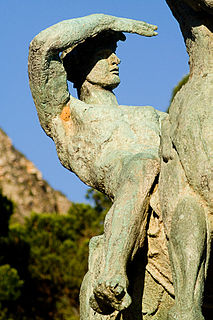Related Research Articles

Harare is the capital and most populous city of Zimbabwe. The city proper has an area of 960.6 km2 (371 mi2) and a population of 2,123,132 in the 2012 census and an estimated 3,120,917 in its metropolitan area in 2019. Situated in north-eastern Zimbabwe in the country's Mashonaland region, Harare is a metropolitan province, which also incorporates the municipalities of Chitungwiza and Epworth. The city sits on a plateau at an elevation of 1,483 metres above sea level and its climate falls into the subtropical highland category.
Berry Bickle is a Zimbabwean artist who resides in Maputo. Born in Bulawayo, Bickle attended the Chisipite Senior School in Harare. Later, she attended the Durban Institute of Technology, where she obtained a national diploma in fine arts, and South Africa's Rhodes University, where she obtained a master's degree in fine arts. Bickle was a founding member of Bulawayo's Visual Artists' Association.
Nicholas Mukomberanwa was a Zimbabwean sculptor and art teacher. He was among the most famous products of the Workshop School at the National Gallery of Zimbabwe and an art mentor and teacher to the Mukomberanwa Family of sculptors. His work has been exhibited in galleries around the world and he remains one of Zimbabwe's most famous artists.

Marshall Philip Baron (1934–1977) was a Rhodesian painter. He exhibited in the United States and South Africa, as well as in Rhodesia. Some of his paintings are today in the National Gallery of Zimbabwe.
Zimbabwean art includes decorative esthetics applied to many aspects of life, including art objects as such, utilitarian objects, objects used in religion, warfare, in propaganda, and in many other spheres. Within this broad arena, Zimbabwe has several identifiable categories of art. It is a hallmark of African cultures in general that art touches many aspects of life, and most tribes have a vigorous and often recognisable canon of styles and a great range of art-worked objects. These can include masks, drums, textile decoration, beadwork, carving, sculpture, ceramic in various forms, housing and the person themselves. Decoration of the body in permanent ways such as scarification or tattoo or impermanently as in painting the body for a ceremony is a common feature of African cultures.

The Avenues is an inner city suburb in Harare, Zimbabwe. Known for its diversity and mixed use activities, the Avenues contains together residential, commercial and entertainment areas, and has a vibrant nightlife with numerous cafes, bars and restaurants. It also holds a busy stretch of shops, retail businesses and office space. As a distinct, named area, the Avenues came into being in the late 1950s, during the Federation, when it drew together several smaller neighbourhoods that were first developed in the early 20th century.

Sculpture and in particular stone sculpture is an art for which Zimbabwe is well known around the world.

First Floor Gallery Harare is Zimbabwe’s first contemporary emerging artist run gallery. The gallery is dedicated to supporting the professional and career development of the new generation of contemporary Zimbabwean artists locally and internationally. The gallery is also dedicated to education and audience development to ensure a sustainable future for career artists. As of 2011, the gallery has also been developing an artist in residence programme bringing senior international artists and scholars to work and exhibit with the gallery and young artists in Harare.
The following is a timeline of the history of the city of Harare, Zimbabwe.

Physical Energy is a bronze equestrian statue by English artist George Frederic Watts. Watts was principally a painter, but also worked on sculptures from the 1870s. Physical Energy was first cast in 1902, two years before his death, and was intended to be Watts's memorial to "unknown worth". Watts said it was a symbol of "that restless physical impulse to seek the still unachieved in the domain of material things". The original plaster maquette is at the Watts Gallery, and there are four full-size bronze casts: one in London, one in Cape Town, one in Harare and one soon to be sited at Watts Gallery - Artists' Village in Compton, Surrey. Other smaller bronze casts were also made after Watts's death.
Wallen Mapondera is a Zimbabwean visual artist, known for work that explores social mores and societal relationships using livestock imagery. His work has been displayed in Australia, Germany, the Netherlands, South Africa, Spain and the United States.
Portia Zvavahera is a Zimbabwean painter.
Derek Huggins was a gallerist based in Zimbabwe. He was born in Kent, England and migrated to Rhodesia in the 1950s where he joined the police force, attaining the rank of Detective Inspector. He opened Gallery Delta in 1975 with his wife Helen Lieros for the promotion of contemporary painting. He managed the gallery up until his death in July 2021. Huggins was the founding director of the National Arts Council of Zimbabwe.
Highlands is a middle class, residential suburb in the east of Harare, best known as the home of the Zimbabwe Broadcasting Corporation, and for its ethnic diversity, history, natural environment and splendid panoramic views of downtown Harare. It is often grouped in the inner east suburbs of Harare such as Eastlea, Highlands, Greendale and Milton Park.
Arcadia, is a small, historic working class suburb, southeast of central Harare and just south of the main railway line that divides the CBD and from its southern suburbs. The area along with nearby, Breaside, St Martins and Hillside, is traditionally a predominately Coloured neighbouhood, who still maintain a majority in the area, though the area has diversified signicantly since the 1980s. The current neighborhood was the second mostly Coloured area developed in the city since the 1930s.
Milton Park is a densely populated, inner city, mixed use suburb just west of central Harare, Zimbabwe. Due to its density, diversity and character it is often compared to The Avenues, Belgravia, Greendale, Eastlea and Highlands. Separated from the CBD by the A1 highway east, is it is usually considered to be bounded to the south by Princes Road, to the north by Cork Road, to the west by Warren Hills Golf Club.
Newlands is a low density, residential suburb located in eastern Harare, Zimbabwe.
Helen Lieros was a Zimbabwean visual artist. She was born in Gweru, Zimbabwe to Greek parents. She studied at the Ecole des Beaux-Arts and the Centre Contemporaine de la Gravure in Geneva, Switzerland. She also spent time at the Istituto statale d'arte di Firenzein Florence, Italy. After wandering in Europe, Lieros returned to Zimbabwe in 1964 and took up a position as a teacher at Chaplin High School, where she had been a student. She moved to Harare in 1967, where she lived until her death on 14 July 2021.
Luis Jose Meque Gugumise was born in Province Tete, Mozambique, but started his art career in Zimbabwe where he moved when he was 20 years old because of civil war that was brewing in his home country. He became a major painter in Harare, but unfortunately died young to AIDS.
Causeway is a commercial district on the southeast edge of central Harare. The area is a busy workaday district that hosts numerous civic institutions, research institutes, and international organizations. Additionally, many government departments and ministries are headquartered here, along with museums such as the National Gallery of Art, are located here.
References
- 1 2 Dewar, Neil. From Salisbury to Harare: the geography of public authority finance and practice under changing ideological circumstances (PhD). University of Cape Town. hdl:11427/17063.
- 1 2 "Editorial Comment: We need our public open spaces back". The Herald . Harare. 21 March 2021.
- ↑ P. Jackson. Historic Buildings of Harare. Quest Publishing, Harare. 1986
- ↑ "Harare's Historic buildings – the Avenues". zimfieldguide.com.
- ↑ "Ranche House (1899) - Ken and Lillian Mew | Zimbabwe Field Guide".
- ↑ "Zim diaspora drives property boom". 19 April 2013.
- ↑ "Harare, capital of Zimbabwe | Zimbabwe Field Guide".
- ↑ "Harare's Greenwood Park reopens – DailyNews".
- ↑ "Greenwood Park 2021, #1 top things to do in harare, harare province, reviews, best time to visit, photo gallery | HelloTravel Zimbabwe".
- ↑ "Greenwood Park". 25 January 2016.
- ↑ "Gallery Delta | Zimbabwe Field Guide".
- ↑ Little Stones. Univ. of Queensland Press. 4 June 2019. ISBN 9780702263538.
- ↑ "Gallery Delta | Zimbabwe Field Guide".
- ↑ Valentine, Victoria L. (24 October 2020). "Zimbabwean Artist Portia Zvavahera Sets New Record at Phillips Evening Auction, Titus Kaphar Painting Far Exceeds Estimate". Culture Type. Retrieved 17 July 2021.
{{cite web}}: CS1 maint: url-status (link)